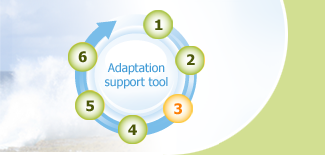
Identifying adaptation options
Adaptation options aim to manage climate risk at an acceptable level and to take advantage of any positive opportunities that may arise. Adaptation options can range from actions that build adaptive capacity, to planning guidelines and infrastructural solutions. This section facilitates an exploration of potential adaptation options and provides examples that have been implemented in both your region and those similar.
Adaptation options can be aimed at:
- accepting the impacts, and bearing the losses that result from risks (eg. managing retreat from sea level rise),
- off-setting losses by sharing or spreading the risks or losses (eg. through insurance),
- avoiding or reducing exposure to climate risks (eg. building new flood defences, or changing location or activity),
- exploiting new opportunities (eg. engaging in a new activity, or changing practices to take advantage of changing climatic conditions).
Another way of considering adaptation options is to think of the types of actions that can be taken. These may be:
- temporary (eg. use large umbrellas to reduce solar heat gains),
- managerial (eg. introduce flexi-time; facilitate working from home),
- technical (eg. refurbish building; enhance flood defences),
- strategic (eg. commission new building with climate resilient design as part of planned capital building programme)
Building adaptive capacity involves developing the ability of people and ecosystems to respond effectively to climate change. This includes gathering and sharing information from the following areas:
- undertaking research,
- monitoring data and company records, and
- raising awareness through education and training initiatives,
and creating a supportive institutional framework, by:
- changing standards,
- legislation,
- best practice guidance, and
- developing appropriate policies, plans and strategies.
